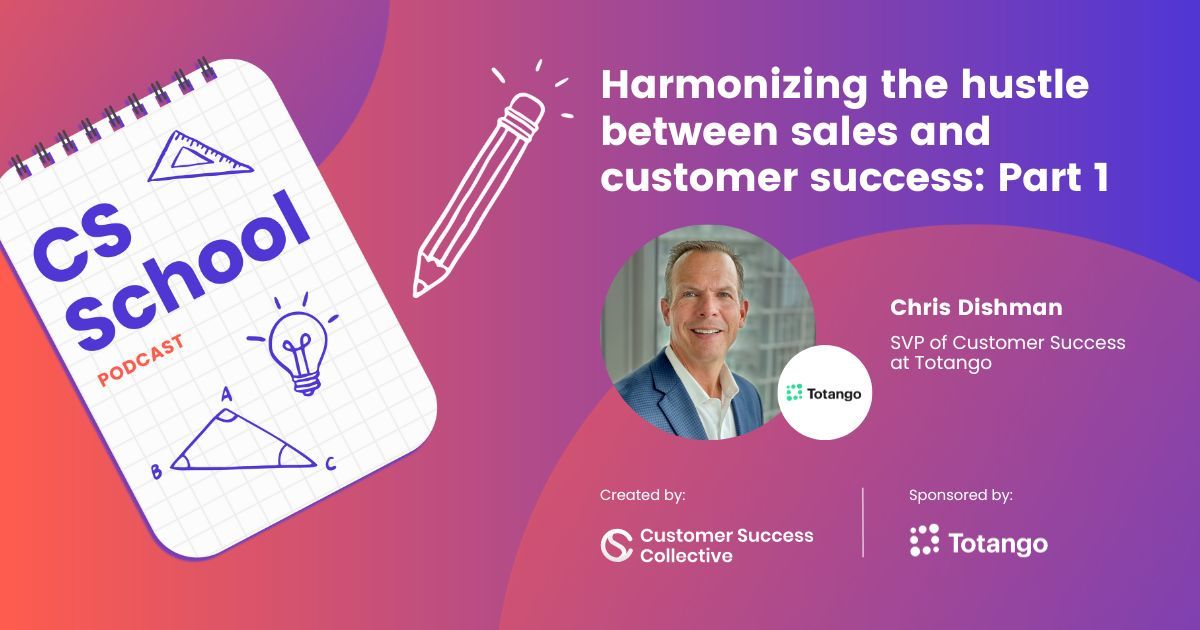This article was based on Kimberly’s appearance on the CS School podcast. Catch up on all episodes.
The intricacies of customer segmentation are critical for any business striving for growth and sustainability. It's far more than just categorizing clients into who’s paying the most per annum; it's about their diverse needs, aligning services accordingly, and crafting personalized success pathways.
My adventure in the realm of customer success has been about pioneering effective segmentation strategies that empower our team to deliver unparalleled value, ensuring we not only meet but surpass our customers' expectations.
In this article, I’m going to challenge some of the traditional views of customer segmentation, specifically explaining
- What we mean by “customer segmentation”
- How we segment our customers at Akeno
- Tailoring customer engagement beyond revenue
- How Akeneo supercharges customer success with tech
- The role of generative AI in customer success
- How you can balance tech touch with a human connection
- How you can monetize customer success
- The challenges I've found in segmenting customers
Understanding customer segmentation
Segmentation is at the heart of all modern customer success strategies, otherwise, you aren’t tailoring your service to cater to your customers' specific needs. That’s the definition of customer segmentation, whether it’s used by marketing or sales teams.
The essence of segmentation is understanding and addressing the unique needs and preferences of each customer.
In the world of customer success, it's about leveraging technology and automation, referred to as "tech touch," to enhance efficiency and achieve customer goals without overwhelming CSMs, who often juggle various responsibilities.
Akeneo’s approach to customer segmentation
At Akeneo, our approach to segmentation is nuanced and tailored to the individual profiles of our customers. This involves considering several factors, including the complexity of the customer's ecosystem, the number of stakeholders involved, and the scope of their goals.
For example, a large, multinational customer with a complex structure across multiple countries and numerous executive champions requires a different approach compared to a smaller, regional business with a niche focus and perhaps just one executive managing several projects.
Conventional segmentation tactics often default to a premium, high-touch model for enterprise clients based solely on their revenue status.
But determining how to engage with each customer involves assessing their specific needs and capacities. Not every customer will have the bandwidth for in-depth executive business reviews or roadmap presentations.
Recognizing this, we categorize our customers based on several criteria:
- Frequency and depth of engagement they require
- Annual recurring revenue (ARR)
- Potential for growth within our platform
The latter is particularly important as it allows us to strategically invest in customers with the capacity to expand their use of our services significantly.
Our segmentation strategy is not solely about categorizing customers by size or revenue but also by the potential value we can unlock together. It’s a holistic view that considers where a customer is in their journey and how we can best support them, ensuring a tailored customer experience that meets them exactly where they are.
This customer-centric approach enables us to allocate our resources effectively, ensuring that each customer receives the attention and support they need to succeed.

Tailoring customer engagement beyond revenue
The fundamental aspect of our customer segmentation approach emphasizes understanding and addressing the distinct needs of each client, beyond merely evaluating their revenue contribution. This nuanced approach acknowledges that while ARR is a significant factor, it's not the sole determinant of the level or type of engagement a customer might require or desire.
Interestingly, there's a growing conversation in the industry around the relevance and value of Quarterly Business Reviews (QBRs) for customers. The emerging consensus suggests that not all customers find these meetings beneficial, challenging the one-size-fits-all model of customer engagement.
This observation aligns with our philosophy that customer success should be about meeting customers where they are, recognizing their unique circumstances, and tailoring our services to align with their specific needs and preferences.
Segmentation enables us to step away from the conventional approach of uniformly applied services, allowing us to focus on what truly benefits each customer. This approach is crucial, especially in addressing the misconception that higher spending automatically necessitates a more hands-on approach.
While high-value accounts do require significant attention, the nature of that attention must align with what the customer actually values and needs, not just what we assume they should receive based on their investment level.
Balancing customer engagement without overstepping or under-delivering is a delicate art. It involves ensuring that customers remain engaged through appropriate channels without overwhelming them with unnecessary meetings or communications.
Technology plays a pivotal role in this balancing act, enabling us to maintain engagement through digital means. For customers less inclined towards frequent direct interactions, such as QBRs or bi-weekly calls, alternative engagement methods can be equally effective. This includes keeping them informed about upcoming webinars, and conferences, or sharing relevant customer stories and insights that might encourage them to initiate contact.
Our commitment to a customer-centric approach is not just about recognizing the financial dimensions of our relationships but, more importantly, understanding and responding to the varying preferences, needs, and expectations of our diverse customer base.
This tailored engagement strategy ensures that every customer feels valued and supported in a manner that resonates with their unique situation, thereby fostering stronger, more meaningful partnerships.

How Akeneo supercharges customer success with technology
Today, the pressure to do more with less has never been more pronounced. At Akeneo, we're embracing technology to meet this challenge head-on, particularly through the use of playbooks and automation tools. We've recently begun implementing a CS software tool called Catalyst to create these playbooks, marking a significant step in enhancing our efficiency.
The process starts by taking a comprehensive look at the customer journey, and identifying critical moments that can make or break the customer experience. Each of these moments is linked to a specific action, whether it's a task for a CSM, a reminder to reach out to a customer, or an automated email providing valuable information or resources.
Our marketing department has been instrumental in this process, developing campaigns that we integrate directly into Catalyst. This ensures that even if a customer doesn't receive frequent direct meetings or calls, they're still in regular contact with us, receiving useful resources and communications.
This strategic use of technology allows us to proactively meet our customers' needs, often before they even have to ask. It's about understanding where customers typically encounter challenges and providing them with the right tools and resources at the right time.
By automating certain aspects of the customer journey, we not only increase our efficiency but also maintain a high level of engagement with our customers, ensuring they have everything they need to succeed. This approach is crucial for scaling our operations while maintaining the quality and personalization of our customer success efforts.

The role of generative AI in customer success
Generative AI, especially platforms like ChatGPT, has become an indispensable tool in the arsenal of customer success at Akeneo. Its impact has been revolutionary, aiding in the creation of content that is engaging, precise, and timely.
While the essence of our communication strives to remain personalized and far from robotic, generative AI has been a game-changer in overcoming common obstacles such as writer’s block, which many of us encounter while drafting email templates or preparing content for customer communications.
One innovative application of generative AI has been in scripting short, informative videos intended for customer engagement.
Recognizing the importance of keeping content concise – ideally no longer than two to three minutes – ChatGPT has provided us with a valuable starting point, saving us considerable time in content creation. This approach aligns with our strategy to diversify our tech touch initiatives, making the customer experience more engaging and dynamic.
Beyond content creation, Akeneo leverages automation and AI through Catalyst for operational efficiencies such as monitoring customer usage thresholds. These automated alerts enable proactive engagement, ensuring customers are aware of upcoming limits or opportunities, seamlessly blending the capabilities of AI with our commitment to exceptional customer service.
The potential applications of AI in customer success extend far beyond what we’ve explored to date. Conversations with other industry professionals, including insights gathered at conferences, highlight the vast array of innovative ways AI can be integrated into customer success strategies.
As we continue to explore these possibilities, our aim is to delve deeper into AI’s capabilities, enhancing our efficiency, and refining our approach to customer engagement. This exploration represents not just a commitment to technological advancement but to continuously evolve our customer success practices to meet and exceed our clients' expectations in the most effective and impactful ways possible.

Balancing tech touch with human connection in customer success
In the journey towards integrating advanced technologies like AI and automation into customer success strategies, striking a balance between efficiency and maintaining a human-centric approach is paramount.
The objective is for these technological enhancements to be imperceptible to the customer, offering a seamless experience that aligns with their expectations without making them feel sidelined.
The key to achieving this balance is understanding the unique needs and engagement patterns of each customer. For instance, a customer who actively participates in bi-weekly meetings, bringing forward numerous questions and requiring detailed discussions, would not be suited for a transition to a low-touch model without careful consideration.
Such decisions are made with the customer's journey in mind, ensuring that any shift towards more automated engagement models occurs at a point where it complements their needs and the natural progression of their projects.

Our approach at Akeneo involves meticulous planning and sensitivity toward the customer's timeline and experience. This process is not abrupt but rather a deliberate strategy that considers the optimal timing for transitioning customers between engagement models. Our commitment to being customer-minded is evident in how we tailor these transitions, ensuring they align with both the customer's requirements and our operational goals.
Adding personal touches, such as incorporating personalized videos in communications or including a picture in email signatures, plays a crucial role in maintaining a sense of personal connection. These elements help to humanize the tech-touch approach, bridging the gap between digital efficiency and the warmth of human interaction.
In managing customer expectations during the transition to more tech-driven interactions, transparency, and preparation are key. Identifying potential challenges and planning for them ensures that we can mitigate any issues before they arise.
By adopting a thoughtful and customer-centric approach to integrating technology into our customer success efforts, we aim to enhance our efficiency while preserving the integrity of the personal relationships that form the foundation of customer success.

Monetizing customer success
Monetizing customer success is a concept that's been gaining traction within the industry, and at Akeneo, we've embarked on an innovative path to realize this. Through extensive research and segmentation efforts, we identified a specific subset of our customer base that requires more than what our standard CSM offerings provide.
These customers, situated beyond the high-touch segment, necessitate what we've termed “hypercare” – a level of service that caters to their intricate needs and demands.
To address this, we’re introducing the Plus plan, a premium service tier that, while paid, delivers significant value through additional technical resources, educational benefits, including access to classroom training, and more.
This plan is designed for customers facing unique challenges or undergoing critical transitions, such as expanding into new markets. The additional cost is justified by the tailored support and resources it provides, enabling these customers to effectively navigate complex projects and achieve their strategic objectives.
The reception to similar initiatives in my past experiences has been overwhelmingly positive. Initially anticipated as a temporary solution for customers during pivotal moments, the enhanced level of service quickly became indispensable to them.
This not only solidified the value of the offering but also presented an opportunity for account expansion and increased ARR. Moreover, it contributed positively to the customer success function's visibility and perceived value within the organization.
The Plus plan stands as a testament to the potential of monetizing customer success – not just as a revenue-generating strategy but as a means to elevate the level of support and partnership we offer our customers. It underscores the importance of recognizing and acting on the unique needs of different customer segments, providing them with tailored solutions that contribute to their success and, by extension, ours.
This approach also highlights the strategic role of customer success in driving business growth, reinforcing the idea that customer success can and should have a direct impact on revenue. It strengthens the case for customer success teams to have a more prominent seat at the executive table, showcasing their contribution not just in terms of customer retention and satisfaction, but also in revenue generation and business expansion.

Identifying and collaborating on monetizable customer success opportunities
Identifying customers who might benefit from enhanced, monetized customer success services often starts with recognizing their heightened need for support. This recognition can come from direct requests for more intensive assistance, frequent professional services engagements, or noticeable strains on a CSM time due to a customer's demands.
Such indicators not only highlight the customer's need for additional support but also signal potential opportunities for introducing premium service offerings like our Plus plan.
The genesis of the Plus plan at Akeneo was directly influenced by our customers' expressed desires for higher levels of service, beyond what standard packages offer. These requests often come in nuanced forms – sometimes as a half-joking desire for duplicating a particularly effective CSM, but more fundamentally, as a clear indication of the need for what we've come to define as hypercare.
This realization prompted us to consider why we weren't already providing such an option and led to the development of a service that addresses these unique demands while also contributing to our revenue.
The relationship between customer success and sales teams is crucial in navigating and capitalizing on these opportunities. At Akeneo, customer success manages expansion directly, with collaboration from sales on larger accounts. Our sales and CS teams work in tandem, much like "peanut butter and jelly," to ensure a harmonious and effective partnership.
This collaboration is facilitated by regular meetings, such as quarterly business reviews, where we discuss customer accounts, potential expansions, and strategize on mutual goals.
Creating a culture of collaboration between sales and customer success is vital for leveraging monetizable opportunities effectively. Understanding each other’s metrics, goals, and methods is fundamental to this process.
For organizations where this relationship might not yet be as strong, investing time in building mutual respect and understanding can significantly enhance the ability to work together towards common objectives. This not only improves the potential for revenue generation through customer success but also enriches the overall customer experience by providing services that meet their evolving needs.

The challenges of customer segmentation
In our journey of segmenting customers at Akeneo, we encountered several challenges, each offering valuable lessons on how to navigate this complex process more effectively.
One significant misstep was in the terminology we used within our internal systems to categorize different segments as high, medium, and low. This inadvertently impacted our CSMs, particularly those managing what was labeled as the "low" segment.
The naming convention, while seemingly innocuous and intended only for internal classification, carried unintended connotations that affected the morale of our CSMs. It highlighted the sensitivity required in internal communications and the importance of considering the implications of the language used.
If I could go back, I would opt for terms that carry a more neutral connotation, such as "digital touch," to describe the various levels of customer engagement, avoiding the unintended hierarchical implications.
Another challenge was the timing and development of our playbooks. In our eagerness to streamline operations, we created digital playbooks before fully understanding the nuances of the customer journey, especially in the digital segment. This premature commitment led to the need for significant revisions and rework.
The lesson here is the value of patience and thorough testing. Running through the customer journey and associated playbooks manually for a period before digitizing them can save time and resources in the long run. It allows for a more adaptable approach, where adjustments can be made based on real-world feedback without the need to overhaul digital systems.
The key takeaway from these experiences is the importance of a thoughtful, deliberate approach to customer segmentation and the implementation of supporting systems. Balancing the needs of both customers and CSMs, while also allowing for flexibility and adaptation, is crucial.
Experimentation and adjustment are inevitable and necessary parts of the process, but with careful planning and open communication, the challenges can be managed effectively. These insights can hopefully guide others in their customer segmentation efforts, helping to avoid similar pitfalls and ensuring a smoother, more responsive approach to meeting the diverse needs of their customer base.
Like this article? We've got a whole lot more in store for you.
If Kimberly's article has stirred a hunger for more CS knowledge, we have just the thing.
You can enroll in our Customer Success Leadership Accelerator program and become one of tomorrow's champions of customer success.
What to expect in this game-changer of a course:
🧠 Non-stop, actionable insights
🔧 Practical applications every week
🤫 Total privacy with your closed CS leadership group
👥 Tons of networking opportunities
📚 Hands-on coursework activities
💡 Endless ideas from your peers and presenters
🔥 Fuel to shape your gold-standard CS strategy



 Follow us on LinkedIn
Follow us on LinkedIn




